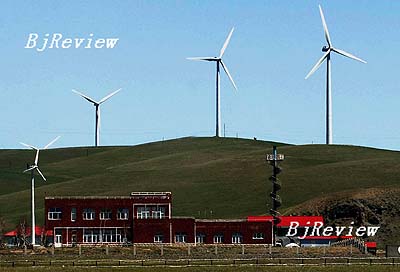|

For the first three quarters of the year, China Huaneng Group has achieved the goal of reducing coal consumption to 339.19 g/kwh, down 7.48 g/kwh from the same period last year.
This owes much to technological improvements in energy conservation and greenhouse gas (GHG) emission reductions, said Wu Ruosi, Deputy General Manager of the state-owned Huaneng Group, which is one of the major electricity suppliers in China.
The enterprise developed a five-year plan on energy saving in early 2006, detailing efficient consumption requirements for coal power plants with a capacity beyond 100,000 kw.
Wu said the company has devoted a considerable sum of capital to developing and employing new techniques to upgrade old electric generating sets, increasing efficiency and cutting consumption.
Yuhuan power plant, which is a subsidiary under the Huaneng Group, lowered electricity-generation coal consumption to 283.2 g/kwh in June 2006, about 366 g/kwh below the national average level and equals to the international average level.
If all the coal-burning power plants in the country can reach the same level as that of the Yuhuan power plant, said Wu, then the nation would burn some 200 million tons of standard coal less and reduce GHG emissions by 540 million tons.
Wu said that 40 percent of the group's coal power plants will be energy-efficient, just like the Yuhuan plant, by the end of 2008.
The electricity company also shuts down small power plants that fail to meet energy saving standards. By the end of September 2007, 55 electric generating sets had been closed.
Clean and efficient
State-owned enterprises (SOEs) should bear the main responsibility for China's energy conservation and GHG emission reduction, said Huang Shuhe, Vice Minister of the State-owned Assets Supervision and Administration Commission (SASAC) of the State Council. State-owned enterprises make up a large part of the country's industrial sector, and the electricity industry is the key to accomplishing the mission of clean and efficient energy.
In China's electricity network, 75 percent is fire-generated, most of which is generated from coal burning. Fire-generated electricity production swallows huge amounts of energy and produces considerable emissions. In 2006, 1.2 billion tons of the country's raw coal was used to generate electricity, making up half of the total coal consumption volume that year.
It is estimated that if all China's small electric generating sets were replaced by large ones, 220 million tons of CO2 emissions would be cut and some 90 million tons of standard coal would be saved, an equivalent to 10 percent of the gross coal consumption in 2005.
At the beginning of 2006, the SASAC ordered that between 2006 and 2010, a capacity of 50 million kw of small electric generating sets that consume greater energy be shut down. Up to now, generating sets with a capacity of 16 million kw have been closed, including 1.86 million from the Huaneng Group.
On September 5, dozens of small electric generating sets in several cities in Shandong Province, most of which belong to state-owned enterprises, were dismantled with a total capacity of more than 700,000 kw. These were sets that consume large amounts of energy and water, and produce large amount of pollution. This action saved the province 1.2 million tons of raw coal and achieved a CO2 emission reduction of 2.8 million tons.
Other key industries that are required to reduce emissions include the steel, oil and chemical sectors. The Aluminium Corporation of China, the country's largest non-ferrous metal corporation, plans to carry out 58 key R&D projects and 117 technology renovations between 2007 and 2010 to save as many as 2.47 million tons of standard coal each year, said the company's General Manager Xiao Yaqing, adding that the company's new aluminium-producing technology could reduce coal consumption by 500,000 tons a year.
Xiao also noted that the company has a set of systems to promote clean production and energy saving. Those who make great achievements in technology innovation will receive incentives and rewards from the company. The team that has developed the new aluminium production technology has already received 1 million yuan ($135,135) as a reward, and each teammate received another individual reward of 300,000 yuan ($40,540).
"It's our responsibility to reduce emissions, also it is an inevitable way toward sustainable development," noted Xiao.
Accountability system
According to Huang, an emission reduction goal for central SOEs between 2007 and 2009 has been set up and includes the petrochemical, steel, electricity, transportation and construction sectors.
The SASAC has urged all its enterprises to draw up detailed steps to help achieve the national green goal. And an accountability system will be implemented for the managers of the 154 SOEs directly under the supervision of the Central Government, starting this September.
"SOEs, which are the pillars of China's economy, should not only do well in profit-making, but also become role models in shouldering corporate responsibility," said SASAC head Li Rongrong.
The accountability system sets green efforts as a decisive factor in determining the career prospects of managers.
The Central Government has already implemented a similar system to tie the careers of government and Party officials with improvements in the local environment.
Currently, the SASAC assesses the performance of the SOE managements mainly on profit-making.
The new system aims to make the leading SOEs tow the green line of the Central Government, which is committed to energy conservation and emission controls.
"It's not only our social responsibility to meet the green goal. In fact, energy saving and pollutant emission reduction can help us save costs and make more profit," said Lu Youqing, Vice President of Aluminum Corporation of China.
The SOEs directly under the supervision of the Central Government-which control all the country's crude oil and natural gas production, generate half of the electricity and account for 15 percent of coal output-have great potential in energy saving and pollutant reduction, Li said. | 